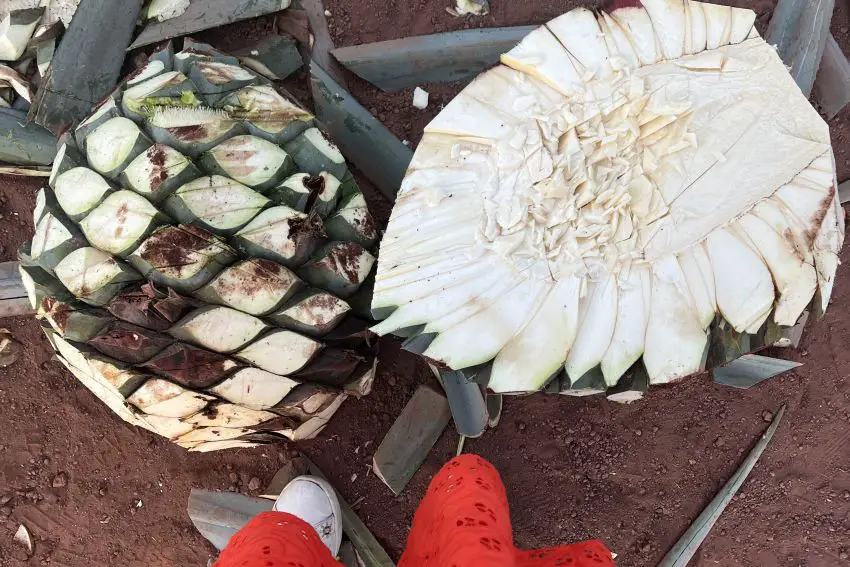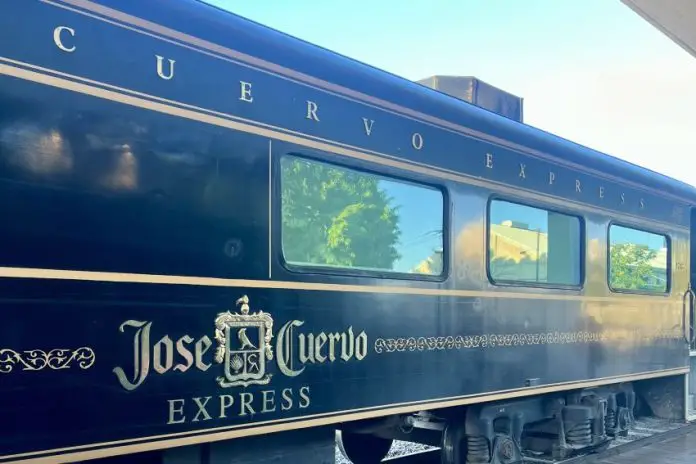I’ll be the first to admit it. I hesitated over the “Book Now” button that would secure my Jose Cuervo Sunrise Express Wagon Train trip from Guadalajara to Tequila, better known as the Tequila train.
Visions of sloppy bachelor parties and guide book-toting tourists with wide-brimmed hats started to swirl through my mind. I quickly pushed these nightmarish reservations to the deep recesses of my brain, took a deep breath, and CLICK.
Booked.

I had decided long ago that there was no way I was going to Guadalajara without hopping on that infamous Tequila train. That’s like going to Paris and not picnicking in front of the Eiffel Tower with a bottle of crisp Champagne. Is it touristy? Yes. Am I a tourist? Also, yes.
But as my long-awaited trip to Jalisco moved closer to reality, so did my reluctance to participate in something that seemed so kitsch. Will the experience be worth the not-so-economical ticket? Will I just be one gringa in a sea of gringo tourists? Do I really want to risk sitting in a packed train car of drunk 20-somethings taking obnoxious videos just to post to social media? Not particularly, but I had to give it a try.
The verdict? I absolutely loved it.
The Tequila train is not to be feared. My assumptions of what to expect were, as assumptions generally are, completely unwarranted.

- There were no sloppy bachelor parties present.
- While there were definitely some TikTok photo shoots going on, it wasn’t anything out of the ordinary.
- Tourists were from all parts of the world — Germany, Spain, Mexico, France, the U.S., Canada, and Britain.
- It was well worth the money. Ample tequila, water, and food were available.
Myself and two friends arrived at the train station, a 30-minute ride from our rented apartment in Colonia Americana. We were greeted by Luis Miguel ballads in the lobby where we checked in. After receiving a wristband we were guided to a waiting area with complimentary cafe de olla, hot chocolate, fruit, and pan dulce.
Twenty minutes before departure, we boarded the train. Recorded mariachi music played with gusto in the nostalgic and elegant train cars. Well-dressed servers presented us with trays of breakfast cocktails, from which I chose (and recommend!) a Paloma. A shot of Vitamin C with my morning tequila couldn’t hurt!
The wheels started rolling promptly at 9:00 a.m. and a guide started talking, giving a brief history of Jose Cuervo, an overview of the landscape, and the differences between types of tequila. While she chatted, guests were offered fruit cups and tacos al vapor and a shot of Jose Cuervo Tradicional Cristalino, which we sipped according to the guide’s instruction.

An hour of unlimited cocktails and water later, we arrived at Tequila, a designated Pueblo Mágico since 2003. We were guided in orderly groups through the Juan Beckmann Gallardo Cultural Center, a museum celebrating Jaliscan culture.
All of which led us to La Rojeña, the oldest distillery in Latin America. We followed the transition cycle of piñas, or agave hearts, from chopping to toasting to liquefying. I had seen piñas in photos but never up close like this, and was struck by how geometric and beautiful they are. They’re also huge — some were double the size of a basketball and weighed 150 pounds!
The end of the distillery tour concluded with a cocktail at 1:00 p.m., at which point we were free to explore and have lunch on our own. We went to Casa Sauza’s highly-rated garden restaurant. The food, tequila, and service were excellent.
Even though the center of Tequila is small, I found that three hours was a perfect amount of time to enjoy our leisurely lunch and exhaust the main sights. We could have popped into the Museum of Tequila (if we wanted to).
Had I not been on the tequila train tour, I would have opted for the equally-kitsch Barril Tequilero, a giant vehicle in the shape of an oak barrel that takes guests through Tequila, stopping at various distilleries.
At 4:10 p.m., we wandered to our next engagement, a live mariachi show which we were sure wouldn’t start on time because, well, this is Mexico.
We were 10 minutes late.

Let me take this moment to reiterate that the experience was extremely well-organized. Having worked as a travel planner myself, I know first-hand the challenge of executing events of this size, and the precision impressed me.
The concert was a blast. Many of the guests were of Mexican heritage, and the entire venue erupted in song multiple times while servers walked around with trays of frozen cocktails.
When the show finished, we boarded buses for a 30-minute ride to the countryside. As urban sprawl gave way to rural terrain, I felt butterflies in my stomach. Mexico does this to me, with its ever-changing landscape full of surprises.
When we arrived at the fields, I had no choice but to rush within the neat rows of spiky agave plants to snap a classic “gringa in the middle of an agave field, hashtag justanothersaturdayinmexico” shot. I was pulled from my photographic glory to witness a short demonstration on how to chop the thing open with an ax, and then the whole dang event turned into a party.
Imagine the scene: a giant, wooden pavilion decorated with string lights, picnic tables, and a dance floor. Food carts abound, offering esquites, churros, palomitas, and tlacoyos, with dozens of bartenders pouring drinks for all. Classic Mexican music pumps from giant speakers and everywhere you look are undulating hills covered in agave. The sun is setting, everyone is laughing and having a good time. It might sound corny, but I found it quite magical.
When it was time to go, each guest was given a final shot for a ‘goodbye cheers’. We boarded our buses and 40 minutes later arrived at Guadalajara, culminating an 11-hour tour. For a visual, watch my reel on Instagram.
View this post on Instagram
Things to note:
- At no point were we encouraged to purchase anything. I found this strange, as I would have been open to buying a bottle from the source, but also refreshing, as it made the experience feel more genuine.
- There are two departure options: Sunrise, which starts at 9:00 a.m., takes you into town by train and back to Guadalaraja by bus. Sunset starts at 11:00 a.m. and does the opposite. The train and bus stations are not close to one another, so if you leave a car at your starting point, you’ll have to Uber back at the end of the tour.
- The bus drop-off is the least organized part of the Sunrise tour. There is a very small parking lot with just a few taxis and hundreds of people ordering carshare simultaneously. I would suggest ordering your Uber as you pull into the parking lot to save time.
- There are four categories to choose from: Express, Premium Plus, Diamond, Elite. My account is based on the Express option.
Bethany Platanella is a travel planner and lifestyle writer based in Mexico City. She lives for the dopamine hit that comes directly after booking a plane ticket, exploring local markets, practicing yoga and munching on fresh tortillas. Sign up to receive her Sunday Love Letters to your inbox, peruse her blog, or follow her on Instagram.
